Hornby, New Zealand facts for kids
Quick facts for kids
Hornby
|
|
|---|---|
|
Suburb
|
|

The Hornby Clocktower building in 2011, a landmark of the suburb prior to its demolition in 2014
|
|
| Country | New Zealand |
| Local authority | Christchurch |
| Electoral ward | Hornby |
| Area | |
| • Land | 1,199 ha (2,963 acre) |
| Population
(June 2023)
|
|
| • Total | 8,340 |
|
|
||
Hornby is a busy suburb located on the western side of Christchurch, New Zealand. It's a key area for homes and shops. Major roads like State Highway 1 connect Hornby to other parts of Christchurch and the wider South Island.
Contents
Hornby's Story: A Look Back
How Hornby Got Its Name
When European settlers first arrived, Hornby was called Southbridge Junction. This was because it was where a main road heading south began.
But there was another town nearby called Southbridge. This caused a lot of confusion! So, in 1878, the area was renamed Hornby. No one is completely sure how the name Hornby came about.
- One idea* is that it was named after a place in England called Hornby-with-Farleton. A man named Frederick William Delamain, who came to Christchurch in 1852, might have named it. He owned land nearby.
- Another idea* is that it was named after Geoffrey Hornby. He was a British Admiral who visited Christchurch in 1870, just before the name change.
Modern Hornby: What's Happened Since
In 1922, a company called Kempthorne Prosser built a factory in Hornby. This factory made super-phosphate, which is a type of fertiliser. Farmers use fertiliser to help plants grow better. This factory is still working today and is now run by a company called Ravensdown. In 2018, there was a big fire at the plant, which caused a lot of smoke.
Hornby used to feel a bit separate from the rest of Christchurch. This was because of the nearby Wigram Aerodrome (an old airport) and big industrial areas. Because of this, some people thought of Hornby as its own town, even though it was always officially part of Christchurch.
Today, Hornby is a lively place with lots to do. It has a special track for cycling and a BMX track for bike tricks. In April 2024, a brand new community centre and swimming pool called Matatiki Hornby Centre opened, giving locals a great place to swim and gather.
Getting Around Hornby
Hornby is a very important spot for roads. It sits on State Highway 1. This highway connects traffic heading south towards places like Dunedin. It also links to Picton in the north, passing by the Christchurch International Airport. From Hornby, you can also easily get to nearby suburbs like Sockburn and Riccarton, and connect to the Christchurch Southern Motorway.
Shopping and Business
Hornby is a major shopping hub with two large malls. They are located on either side of State Highway 1.
- The Hub Hornby opened in 1976. It's a big mall with over 800 parking spots and 82 different shops. You can find popular stores like Pak'nSave and Farmers here.
- Dress Smart Christchurch is an outlet mall that opened in 1999. This means you can often find good deals on clothes and other items. It expanded in 2005 and now has 53 stores and 347 parking spots.
Sports and Fun
Hornby is a great place for sports! There are many different sports clubs in the area:
- Hornby Netball Club
- Christchurch Junior Cricket Association
- Hornby Soccer
- Westside Sports Club
- Hornby Touch Club
- ISL Hornby Women's Football Club
- Burnham Golf Club
- Hornby Working Men's Club
- Pegasus Cycling Club
Learning in Hornby
Hornby has several schools for students of different ages:
- Hornby High School is a secondary school for students in years 7 to 13. It opened in 1975.
- Hornby Primary School and South Hornby School are primary schools for younger students in years 1 to 6. Hornby Primary opened way back in 1895!
All these schools welcome both boys and girls.


